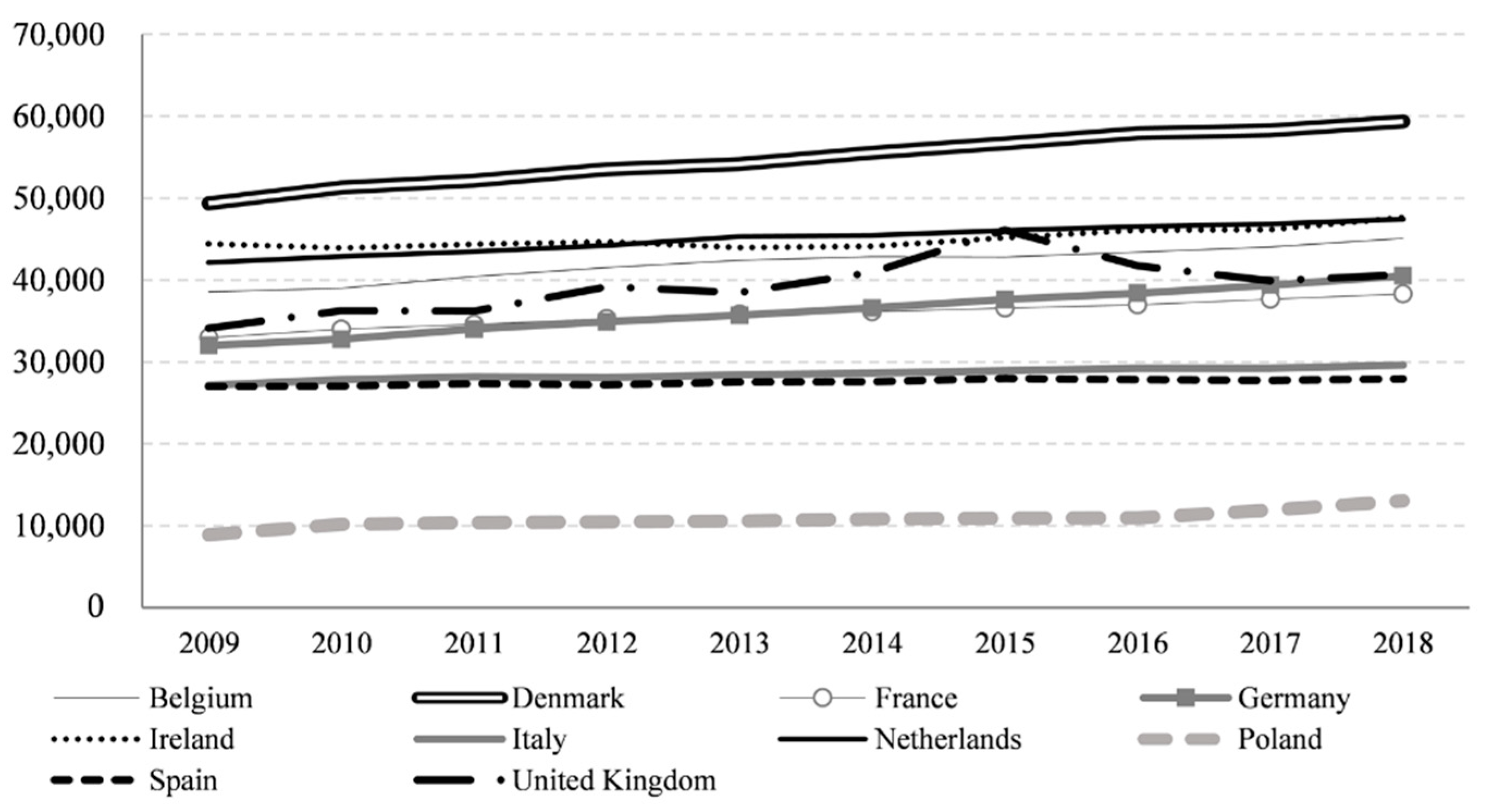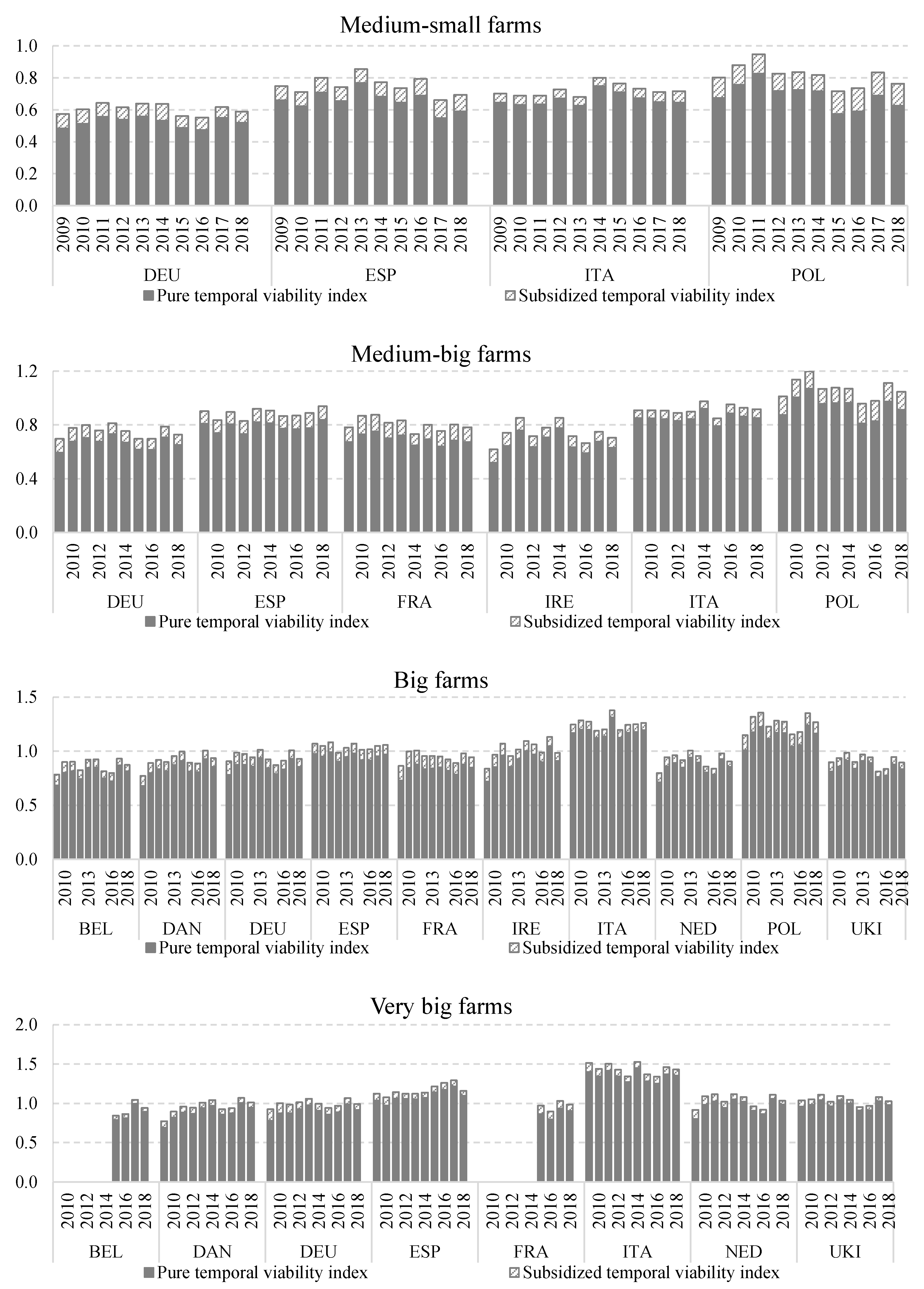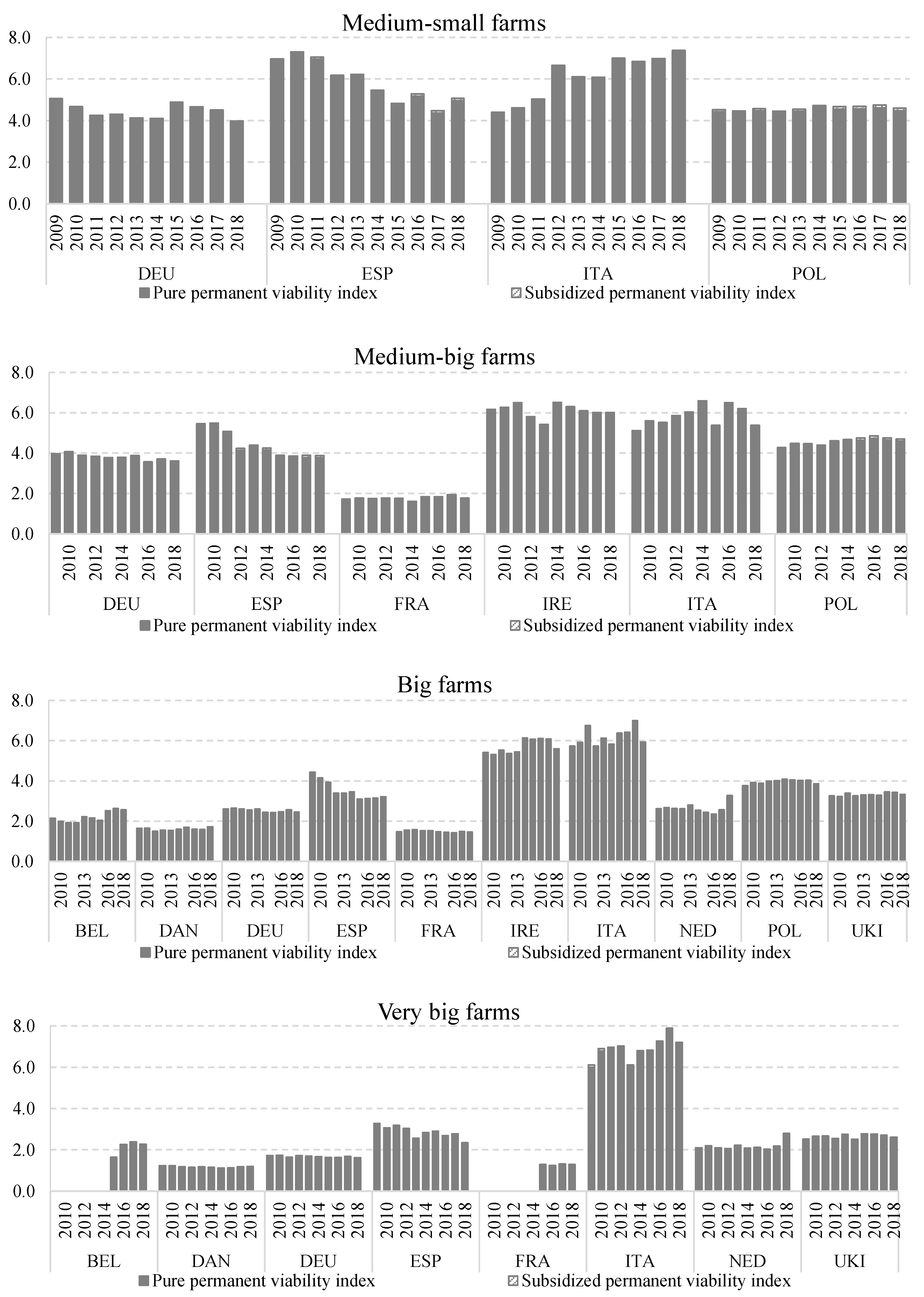Economic Resilience of EU Dairy Farms: An Evaluation of Economic Viability
Abstract
1. Introduction
- Opportunity cost allowing to determine whether it would be more profitable for the farmer and his family to provide work outside the farm and invest the capital in other projects,
- Cost of own capital (COC) reflecting the farm’s ability to cover opportunity costs of capital, which means that the farm has the funds to invest,
- Viability threshold, defined as the average wage in the economy or in agriculture (as research shows, it can be adopted as the minimum wage in agriculture).
2. Materials and Methods
2.1. Conception of Comparative Analysis
- Temporal viability index (short-term viability);
- Permanent viability index (long-term viability).
- The survival phase occurs when the farm generates an income that is lower than the potential income from outside the farm business. This phase is indicated by a value of the farm temporal viability index below 1.0. The results of Glover and Reay [28] show that family dairy farms are able to continue farming despite minimal economic returns by implementing different strategic behaviors (diversifying the business, debt maximizing, sacrificing family needs and compromising). The choice of behavior is determined by the needs of the family and the business to ensure the survival of the farm for future generations and the maintenance of socioemotional wealth.
- In the life phase there are farms where the level of net value added makes it possible to meet the needs of the farmer and his family. In addition, the farmer can develop needs and decide how to satisfy them. This means that farmers will not necessarily focus their activities on growth or development, as meeting the needs of the family may take priority. The farm in the life phase achieves the temporal viability index in the range of 1.0–1.2.
- The development phase occurs when, after meeting the needs of the farmer and his family, some of the income allows to increase the farm’s potential remains. This means that farmers can allocate resources for farm development. The development phase is confirmed by the value of viability index exceeding 1.2.
2.2. Descriptions of Farm Groups and Their Economic Viability Components in 2009–2018
3. Results
3.1. The Short-Term Economic Viability
3.2. The Long-Term Economic Viability
4. Discussion
5. Conclusions
Author Contributions
Funding
Institutional Review Board Statement
Informed Consent Statement
Data Availability Statement
Conflicts of Interest
References
- Clay, N.; Garnett, T.; Lorimer, J. Dairy Intensification: Drivers, Impacts and Alternatives. Ambio 2020, 49, 35–48. [Google Scholar] [CrossRef] [PubMed]
- Davidson, A. Globalisation, Uneven Development and Marginalisation: Dairy Restructuring in New South Wales. Aust. J. Soc. Issues 2002, 37, 85–102. [Google Scholar] [CrossRef]
- Barnes, A.P.; Hansson, H.; Manevska-Tasevska, G.; Shrestha, S.S.; Thomson, S.G. The influence of diversification on long-term viability of the agricultural sector. Land Use Policy 2015, 49, 404–412. [Google Scholar] [CrossRef]
- Hennessy, T. CAP 2014–2020 Tools to Enhance Family Farming: Opportunities and Limits in-Depth Analysis. (IP/B/AGRI/CEI/2011-097/E026/SC1); Policy Department B: Structural and Cohesion Policies European Parliament. 2014. Available online: https://www.europarl.europa.eu/RegData/etudes/note/join/2014/529051/IPOL-AGRI_NT(2014)529051_EN.pdf (accessed on 16 February 2021).
- Loughrey, J.; Hennessy, T. Farm Income Variability and Off-Farm Employment in Ireland. AFR 2016, 76, 378–401. [Google Scholar] [CrossRef]
- Nurmet, M.; Omel, R. ECONOMIC VIABILITY BY FARM SIZE OF ESTONIAN FAMILY FARMS. Zagadnienia Ekon. Rolnej/Probl. Agric. Econ. 2020, 362, 14–28. [Google Scholar] [CrossRef]
- Barnes, A.P.; Thomson, S.G.; Ferreira, J. Disadvantage and Economic Viability: Characterising Vulnerabilities and Resilience in Upland Farming Systems. Land Use Policy 2020, 96, 104698. [Google Scholar] [CrossRef]
- Christensen, L.; Limbach, L. Finding Common Ground: Defining Agricultural Viability and Streamlining Multi-Organization Data Collection. J. Agric. Food Syst. Community Dev. 2019, 8, 137–152. [Google Scholar] [CrossRef]
- O’Donoghue, C.; Hennessy, T. Policy and Economic Change in the Agri-Food Sector in Ireland. Econ. Soc. Rev. 2015, 46, 315–337. Available online: https://www.esr.ie/article/view/344/112 (accessed on 16 February 2021).
- O’Donoghue, C.; Devisme, S.; Ryan, M.; Conneely, R.; Gillespie, P.; Vrolijk, H. Farm Economic Sustainability in the European Union: A Pilot Study. Stud. Agric. Econ. 2016, 118, 163–171. [Google Scholar] [CrossRef]
- Spicka, J.; Hlavsa, T.; Soukupova, K.; Stolbova, M. Approaches to Estimation the Farm-Level Economic Viability and Sustainability in Agriculture: A Literature Review. Agric. Econ. 2019, 65, 289–297. [Google Scholar] [CrossRef]
- Latruffe, L.; Diazabakana, A.; Bockstaller, C.; Desjeux, Y.; Finn, J.; Kelly, E.; Ryan, M.; Uthes, S. Measurement of Sustainability in Agriculture: A Review of Indicators. Stud. Agr. Econ. 2016, 118, 123–130. [Google Scholar] [CrossRef]
- Savickiene, J.; Miceikiene, A.; Jurgelaitiene, L. Assessment of economic viability in agriculture. In Strategic Approaches in Economy, Governance and Business, 2nd ed.; Zbuchea, A., Pînzaru, F., Eds.; Tritonic: Bucharest, Romania, 2016; pp. 101–118. [Google Scholar]
- Zorn, A.; Esteves, M.; Baur, I.; Lips, M. Financial Ratios as Indicators of Economic Sustainability: A Quantitative Analysis for Swiss Dairy Farms. Sustainability 2018, 10, 2942. [Google Scholar] [CrossRef]
- Ryan, M.; Hennessy, T.; Buckley, C.; Dillon, E.J.; Donnellan, T.; Hanrahan, K.; Moran, B. Developing Farm-Level Sustainability Indicators for Ireland Using the Teagasc National Farm Survey. Ir. J. Agric. Food Res. 2016, 55, 112–125. [Google Scholar] [CrossRef]
- Hooks, T.; Macken-Walsh, Á.; McCarthy, O.; Power, C. Farm-Level Viability, Sustainability and Resilience: A Focus on Cooperative Action and Values-Based Supply Chains. Stud. Agric. Econ. 2017, 119, 123–129. [Google Scholar] [CrossRef]
- Miceikiene, A.; Girdžiute, L. Farmers’ Economic Viability Assessment in the Context of Taxation and Support. In International Scientific Days 2016: The Agri-Food Value Chain: Challenges for Natural Resources Management and Society: Proceedings; Slovak University of Agriculture in Nitra: Nitra, Slovakia, 2016; pp. 350–360. [Google Scholar] [CrossRef]
- Coppola, A.; Scardera, A.; Amato, M.; Verneau, F. Income Levels and Farm Economic Viability in Italian Farms: An Analysis of FADN Data. Sustainability 2020, 12, 4898. [Google Scholar] [CrossRef]
- Esteves, M.; Zorn, A.; Baur, I.; Lips, M. Financial ratios as indicators of economic sustainability: Synergies and trade-offs for Swiss dairy farms. In Proceedings of the 21st International Farm Management Congress, John McIntyre Conference Centre, Edinburgh, Scotland, UK, 2–7 July 2017; pp. 1–15. Available online: https://ifmaonline.org/contents/financial-ratios-as-indicators-of-economic-sustainability-synergies-and-trade-offs-for-swiss-dairy-farms/ (accessed on 16 February 2021).
- Benidir, M.; Ghozlane, F.; Bousbia, A.; Belkheir, B. The Use of a Critical Analysis of a Multicriterion Method (IDEA) for Assessing the Sustainability of Sedentary Sheep Rearing Systems in the Algerian Steppe Areas. AJAR 2013, 8, 804–811. [Google Scholar] [CrossRef]
- Vrolijk, H.C.; De Bont, C.J.; Blokland, P.W.; Soboh, R.A. Farm Viability in the European Union: Assessment of the Impact of Changes in Farm Paymen; LEI Wageningen UR: The Hague, The Netherlands, 2010. [Google Scholar]
- Barnes, A.P.; Rutherford, K.M.D.; Langford, F.M.; Haskell, M.J. The Effect of Lameness Prevalence on Technical Efficiency at the Dairy Farm Level: An Adjusted Data Envelopment Analysis Approach. J. Dairy Sci. 2011, 94, 5449–5457. [Google Scholar] [CrossRef]
- Savickienė, J.; Miceikienė, A. Sustainable Economic Development Assessment Model for Family Farms. Agric. Econ. 2018, 64, 527–535. [Google Scholar] [CrossRef]
- European Commission. Farm Accounting Data—An A to Z of Methodology. Version 02/07/2018. Available online: http://ec.europa.eu/agriculture/rica//pdf/site_en.pdf (accessed on 18 February 2021).
- Scotti, E.; Bergmann, H.; Henke, R.; Hovorka, G. Evaluation of Income Effects of Direct Support: Final Report. EEIG AGROSYNERGIE, 261. 2011, p. 184. Available online: https://op.europa.eu/en/publication-detail/-/publication/1ab836ce-38f1-4bed-873e-fe2a3477b0d2 (accessed on 18 February 2021).
- Bossel, H. Assessing Viability and Sustainability: A Systems-Based Approach for Deriving Comprehensive Indicator Sets. Conserv. Ecol. 2001, 5. [Google Scholar] [CrossRef]
- Scott, J. Farm and Community Viability. Report on Interview Results. GPI Atlantic. 2003, pp. 26–37. Available online: http://www.gpiatlantic.org/pdf/agriculture/farmviab.pdf (accessed on 20 April 2021).
- Glover, J.L.; Reay, T. Sustaining the Family Business with Minimal Financial Rewards: How Do Family Farms Continue? Fam. Bus. Rev. 2015, 28, 163–177. [Google Scholar] [CrossRef]
- OECD.Stat. Available online: https://www.oecd-ilibrary.org/economics/data/oecd-stat/data-warehouse_data-00900-en (accessed on 15 December 2020).
- Krpalkova, L.; Cabrera, V.E.; Kvapilik, J.; Burdych, J. Dairy Farm Profit According to the Herd Size, Milk Yield, and Number of Cows per Worker. Agric. Econ. Czech 2016, 62, 225–234. [Google Scholar] [CrossRef]
- Wilson, P. Decomposing Variation in Dairy Profitability: The Impact of Output, Inputs, Prices, Labour and Management. J. Agric. Sci. 2011, 149, 507–517. [Google Scholar] [CrossRef]
- MacDonald, J.; Newton, D.; MacDonald, J.; Newton, D. Milk Production Continues Shifting to Large-Scale Farms. 2014. Available online: https://ageconsearch.umn.edu/record/210017 (accessed on 20 April 2021). [CrossRef]
- Coppola, A.; Scalera, D.; Tosco, D. Economic Profitability and Long-Term Viability in Italian Agriculture. Politica Agric. Internazionale Int. Agric. Policy 2013. [Google Scholar] [CrossRef]
- Augère-Granier, M.-L. The EU Dairy Sector. Main Features, Challenges and Prospects. Briefing European Parliament; European Parliament: Brussels, Belgium, 2018; Available online: https://www.europarl.europa.eu/thinktank/en/document.html?reference=EPRS_BRI(2018)630345 (accessed on 20 April 2021).
- Bergmann, D.; O’Connor, D.; Thümmel, A. An Evaluation of Point and Density Forecasts for Selected eu Farm Gate Milk Prices. Int. J. Food Agric. Econ. (IJFAEC) 2019, 6, 23–53. [Google Scholar] [CrossRef]
- Klopčič, M.; Kuipers, A.; Malak-Rawlikowska, A.; Stalgiene, A.; Ule, A.; Erjavec, K. Dairy Farmers’ Strategies in Four European Countries before and after Abolition of the Milk Quota. Land Use Policy 2019, 88, 104169. [Google Scholar] [CrossRef]
- Popescu, A.; Stoian, E.; Șerban, V. The EU-28 milk sector trends in the period 2009–2018. Sci. Pap. Manag. Econ. Eng. Agric. Rural Dev. 2019, 19, 249–263. [Google Scholar]
- Koloszycz, E. The Economic Impact of Crisis on Milk Market in Selected Dairy Farms in Europe. In Proceedings of the 2018 International Conference “Economic Science for Rural Development”, Jelgava, Latvia, 9–11 May 2018; pp. 460–467. [Google Scholar] [CrossRef]



| Medium-Small Farms) 25,000 EUR ≤ SO < 50,000 EUR | Medium-Large Farms 50,000 EUR ≤ SO < 100,000 EUR | Large Farms 100,000 EUR ≤ SO < 500,000 EUR | Very Large Farms SO ≥ 500,000 EUR |
|---|---|---|---|
| Germany, Poland, Italy, Spain | Germany, France, Poland, Italy, Ireland, Spain | Germany, France, United Kingdom, Netherlands, Poland, Italy, Ireland, Spain, Denmark, Belgium | Germany, France, United Kingdom, Netherlands, Italy, Spain, Denmark, Belgium |
| Economic Size Classes (ES6) | Country | Dairy Cows (Heads) | Milk Yield (tons) | Total Utilised Agricultural Area (ha) | Total Output per AWU (1000 EUR/AWU) | Share of Unpaid Labor Input in Total Labor Input (%) | Stocking Density (LU/ha Forage Area) | Output/input Ratio (%) |
|---|---|---|---|---|---|---|---|---|
| Medium-small farms | DEU | 13.0 | 5.3 | 19.2 | 38.1 | 98.9 | 1.2 | 107.9 |
| ESP | 15.2 | 6.7 | 13.7 | 33.5 | 99.8 | 1.6 | 127.3 | |
| ITA | 13.8 | 4.8 | 13.7 | 39.3 | 96.8 | 1.7 | 134.9 | |
| POL | 16.4 | 4.8 | 22.0 | 16.8 | 98.7 | 1.8 | 128.9 | |
| Medium-large farms (4) | DEU | 23.9 | 5.5 | 30.1 | 31.2 | 98.0 | 1.6 | 115.1 |
| ESP | 27.5 | 6.8 | 20.3 | 50.6 | 96.3 | 2.0 | 126.3 | |
| FRA | 31.6 | 5.8 | 53.4 | 64.9 | 96.5 | 1.1 | 96.2 | |
| IRE | 38.5 | 5.1 | 39.6 | 64.0 | 96.8 | 1.7 | 123.8 | |
| ITA | 28.1 | 5.0 | 24.1 | 58.8 | 88.5 | 2.0 | 143.9 | |
| POL | 30.3 | 5.9 | 37.7 | 33.3 | 95.6 | 1.9 | 136.5 | |
| Large farms | BEL | 67.3 | 7.2 | 53.5 | 114.1 | 98.1 | 2.3 | 121.6 |
| DEN | 76.5 | 8.3 | 83.8 | 206.2 | 74.5 | 2.1 | 100.0 | |
| DEU | 66.0 | 7.5 | 73.4 | 128.8 | 85.5 | 2.0 | 109.8 | |
| ESP | 70.7 | 7.2 | 41.3 | 93.0 | 83.6 | 2.9 | 121.9 | |
| FRA | 65.9 | 7.0 | 104.0 | 106.7 | 88.1 | 1.5 | 102.1 | |
| IRE | 91.2 | 5.6 | 74.4 | 126.9 | 80.9 | 2.1 | 128.4 | |
| ITA | 78.6 | 5.8 | 44.,1 | 120.9 | 78.9 | 3.2 | 157.3 | |
| NED | 77.2 | 8.0 | 46.3 | 167.0 | 89.1 | 2.4 | 111.1 | |
| POL | 63.5 | 7.0 | 77.8 | 62.1 | 79.6 | 1.9 | 137.8 | |
| UKI | 97.7 | 7.0 | 88.1 | 133.7 | 71.6 | 1.9 | 108.4 | |
| Very large farms | BEL | 154.8 | 8.2 | 101.8 | 184.0 | 92.5 | 2.8 | 116.2 |
| DEN | 231.0 | 9.2 | 215.1 | 299.6 | 33.3 | 2.2 | 94.4 | |
| DEU | 298.3 | 8.6 | 422.5 | 135.9 | 17.3 | 1.9 | 94.7 | |
| ESP | 298.3 | 8.4 | 97.1 | 153.2 | 40.9 | 5.6 | 117.5 | |
| FRA | 175.1 | 7.9 | 237.4 | 154.1 | 74.9 | 2.0 | 99.5 | |
| ITA | 260.4 | 7.2 | 110.8 | 221.9 | 47.0 | 5.1 | 150.9 | |
| NED | 201.0 | 8.3 | 107.0 | 275.6 | 75.2 | 2.8 | 112.6 | |
| UKI | 255.8 | 7.6 | 201.4 | 188.5 | 41.0 | 2.3 | 109.4 |
| Economic Size Classes (ES6) | Country | Total Output | Total Direct Payments | Total Intermediate Consumption | Depreciation | Taxes | Total External Factors | Total Unpaid Labor Wages | Total Assets | Total Liabilities |
|---|---|---|---|---|---|---|---|---|---|---|
| Medium-small farms | DEU | 41.8 | 6.6 | 29.2 | 7.6 | 0.6 | 1.9 | 41.1 | 380.2 | 15.4 |
| ESP | 39.0 | 5.6 | 27.6 | 2.8 | 0.2 | 0.2 | 28.7 | 309.7 | 1.4 | |
| ITA | 49.4 | 4.3 | 27.0 | 7.8 | 1.4 | 1.6 | 36.3 | 428.3 | 5.3 | |
| POL | 31.3 | 5.7 | 18.1 | 5.5 | 0.3 | 0.8 | 21.1 | 211.2 | 7.9 | |
| Medium-large farms | DEU | 79.0 | 10.3 | 51.3 | 13.0 | 0.7 | 4.8 | 49.2 | 510.9 | 38.4 |
| ESP | 70.5 | 8.8 | 50.7 | 3.6 | 0.2 | 1.6 | 33.3 | 332.3 | 3.9 | |
| FRA | 83.5 | 13.6 | 61.1 | 18.8 | 1.1 | 6.9 | 33.1 | 247.9 | 73.8 | |
| IRE | 86.9 | 10.9 | 59.3 | 7.2 | 0.2 | 3.8 | 62.2 | 837.8 | 20.0 | |
| ITA | 98.0 | 7.0 | 52.3 | 10.6 | 2.2 | 5.0 | 44.4 | 634.4 | 11.4 | |
| POL | 69.4 | 9.6 | 38.1 | 10.5 | 0.4 | 2.2 | 23.0 | 390.1 | 27.2 | |
| Large farms | BEL | 201.7 | 19.9 | 117.6 | 29.6 | 2.0 | 18.6 | 88.3 | 765.9 | 193.8 |
| DEN | 361.8 | 37.3 | 270.6 | 33.5 | 4.0 | 66.4 | 61.2 | 2100.9 | 1128.7 | |
| DEU | 237.0 | 24.7 | 155.5 | 35.8 | 1.7 | 24.7 | 59.4 | 922.4 | 190.3 | |
| ESP | 197.5 | 19.3 | 142.8 | 10.3 | 0.3 | 9.1 | 45.4 | 601.2 | 25.7 | |
| FRA | 238.2 | 27.1 | 164.5 | 42.3 | 2.1 | 24.5 | 63.6 | 510.2 | 251.2 | |
| IRE | 228.7 | 23.9 | 139.8 | 18.9 | 0.3 | 19.8 | 72.1 | 1776.7 | 104.6 | |
| ITA | 294.8 | 18.0 | 152.8 | 16.1 | 3.7 | 18.0 | 58.7 | 1362.8 | 20.5 | |
| NED | 280.8 | 21.0 | 171.9 | 37.4 | 4.2 | 43.4 | 73.3 | 2536.4 | 745.0 | |
| POL | 172.0 | 18.1 | 94.4 | 22.1 | 0.8 | 8.6 | 25.8 | 797.1 | 97.3 | |
| UKI | 299.7 | 23.1 | 218.0 | 31.3 | 0.5 | 27.4 | 77.4 | 1450.9 | 179.3 | |
| Very large farms | BEL | 519.6 | 31.1 | 324.4 | 74.4 | 3.8 | 49.8 | 140.3 | 2002.6 | 607.3 |
| DEN | 1127.6 | 91.5 | 784.4 | 113.4 | 10.7 | 298.7 | 68.8 | 5516.1 | 4465.9 | |
| DEU | 1272.6 | 133.2 | 879.9 | 146.4 | 10.9 | 320.1 | 58.2 | 3025.6 | 1222.9 | |
| ESP | 957.3 | 67.8 | 676.6 | 44.5 | 1.8 | 92.2 | 63.6 | 1966.3 | 168.4 | |
| FRA | 644.6 | 70.8 | 435.8 | 126.1 | 5.1 | 86.8 | 81.8 | 1450.2 | 945.3 | |
| ITA | 1148.4 | 74.4 | 616.8 | 41.8 | 18.6 | 102.1 | 72.1 | 4833.1 | 17.2 | |
| NED | 764.5 | 55.8 | 444.4 | 104.5 | 9.4 | 128.5 | 106.3 | 6215.3 | 2428.7 | |
| UKI | 856.0 | 49.8 | 594.6 | 71.0 | 0.7 | 117.1 | 89.9 | 2998.8 | 599.9 |
Publisher’s Note: MDPI stays neutral with regard to jurisdictional claims in published maps and institutional affiliations. |
© 2021 by the authors. Licensee MDPI, Basel, Switzerland. This article is an open access article distributed under the terms and conditions of the Creative Commons Attribution (CC BY) license (https://creativecommons.org/licenses/by/4.0/).
Share and Cite
Wilczyński, A.; Kołoszycz, E. Economic Resilience of EU Dairy Farms: An Evaluation of Economic Viability. Agriculture 2021, 11, 510. https://doi.org/10.3390/agriculture11060510
Wilczyński A, Kołoszycz E. Economic Resilience of EU Dairy Farms: An Evaluation of Economic Viability. Agriculture. 2021; 11(6):510. https://doi.org/10.3390/agriculture11060510
Chicago/Turabian StyleWilczyński, Artur, and Ewa Kołoszycz. 2021. "Economic Resilience of EU Dairy Farms: An Evaluation of Economic Viability" Agriculture 11, no. 6: 510. https://doi.org/10.3390/agriculture11060510
APA StyleWilczyński, A., & Kołoszycz, E. (2021). Economic Resilience of EU Dairy Farms: An Evaluation of Economic Viability. Agriculture, 11(6), 510. https://doi.org/10.3390/agriculture11060510





